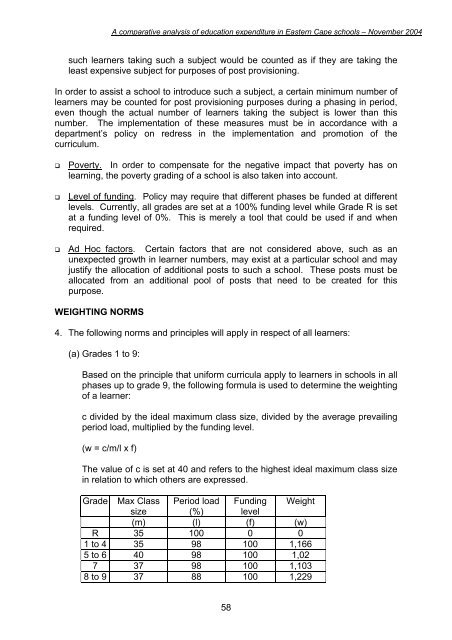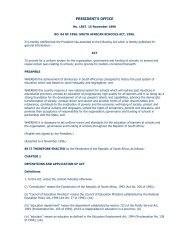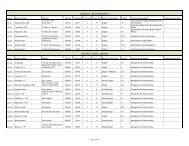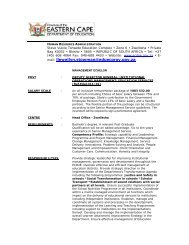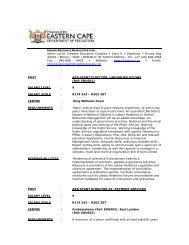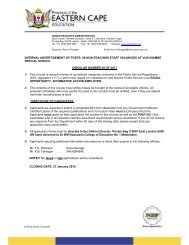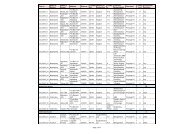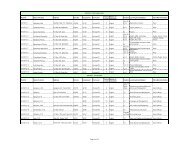School Community Integration Pilot Project - Department of Education
School Community Integration Pilot Project - Department of Education
School Community Integration Pilot Project - Department of Education
Create successful ePaper yourself
Turn your PDF publications into a flip-book with our unique Google optimized e-Paper software.
A comparative analysis <strong>of</strong> education expenditure in Eastern Cape schools – November 2004<br />
such learners taking such a subject would be counted as if they are taking the<br />
least expensive subject for purposes <strong>of</strong> post provisioning.<br />
In order to assist a school to introduce such a subject, a certain minimum number <strong>of</strong><br />
learners may be counted for post provisioning purposes during a phasing in period,<br />
even though the actual number <strong>of</strong> learners taking the subject is lower than this<br />
number. The implementation <strong>of</strong> these measures must be in accordance with a<br />
department’s policy on redress in the implementation and promotion <strong>of</strong> the<br />
curriculum.<br />
<br />
<br />
<br />
Poverty. In order to compensate for the negative impact that poverty has on<br />
learning, the poverty grading <strong>of</strong> a school is also taken into account.<br />
Level <strong>of</strong> funding. Policy may require that different phases be funded at different<br />
levels. Currently, all grades are set at a 100% funding level while Grade R is set<br />
at a funding level <strong>of</strong> 0%. This is merely a tool that could be used if and when<br />
required.<br />
Ad Hoc factors. Certain factors that are not considered above, such as an<br />
unexpected growth in learner numbers, may exist at a particular school and may<br />
justify the allocation <strong>of</strong> additional posts to such a school. These posts must be<br />
allocated from an additional pool <strong>of</strong> posts that need to be created for this<br />
purpose.<br />
WEIGHTING NORMS<br />
4. The following norms and principles will apply in respect <strong>of</strong> all learners:<br />
(a) Grades 1 to 9:<br />
Based on the principle that uniform curricula apply to learners in schools in all<br />
phases up to grade 9, the following formula is used to determine the weighting<br />
<strong>of</strong> a learner:<br />
c divided by the ideal maximum class size, divided by the average prevailing<br />
period load, multiplied by the funding level.<br />
(w = c/m/l x f)<br />
The value <strong>of</strong> c is set at 40 and refers to the highest ideal maximum class size<br />
in relation to which others are expressed.<br />
Grade Max Class Period load Funding Weight<br />
size (%) level<br />
(m) (l) (f) (w)<br />
R 35 100 0 0<br />
1 to 4 35 98 100 1,166<br />
5 to 6 40 98 100 1,02<br />
7 37 98 100 1,103<br />
8 to 9 37 88 100 1,229<br />
58


